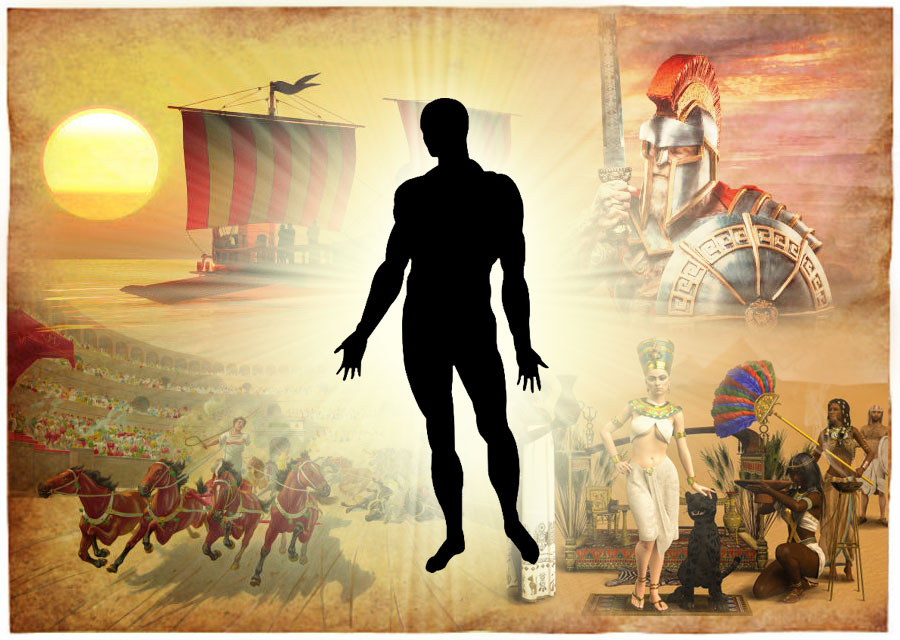Past Life Patterns
 by Rosemary Ellen Guiley
by Rosemary Ellen Guiley
In 1966, Helen Wambach, an American psychologist and clinical psychiatrist, visited a Quaker memorial in Holly, New Jersey, and suddenly found herself in an altered state of consciousness, and a feeling of being in another time and place came over her.
As I entered the small library room, I saw myself going automatically to the shelf of books and taking one down. I seemed to ‘know’ that this had been my book, and as I looked at the pages, a scene came before my inner eye. I was riding on a mule across a stubbled field, and this book was propped up on the saddle in front of me. The sun was hot on my back, and my clothes were scratchy. I could feel the horse moving under me while I sat in the saddle, deeply absorbed in reading the book propped before me. The book I was reading was a report of a minister’s experience of the between-life state while he was in a coma. I seemed to know the book’s contents before I turned the pages.
Wambach’s experience took her by surprise, and led her to investigate reincarnation through hypnotic regression. After ten years and regression sessions with 1,088 subjects, she had amassed considerable data concerning patterns in past-life regressions, which she published in her first book Reliving Past Lives. As she pursued her study, she understood some of the odd cases she had encountered as a psychotherapist since 1955—like Peter, a five-year-old black boy who told her about his life as a rookie policeman who smoked. Peter wanted to smoke and could not understand why he was forbidden to do so. The boy’s mother, who said he had talked about the policeman from age three, had discouraged him from “making up stories.”
Wambach divided her regressions into time periods from 2000 B.C.E. to the twentieth century; not all subjects, of course, had lives in each period. She regressed her subjects to a time period and asked them about their sex, race, social class, clothing and footwear, utensils and their death experience. Among her more significant findings were:
—49.4 percent of past lives were as females and 50.6 percent as men, which matches true biological balance.
—The large majority of lives fell into the lower class in all time periods, from just under 70 percent in 2000 B.C.E. to a high of nearly 80 percent around 500 B.C.E. to nearly 70 percent again in the 1900s. Throughout all time periods, upper class lives constituted fewer than 10 percent. The middle class reached peaks of between 30 and 40 percent around 1000 B.C.E. and in the eighteenth century.
—World population figures, extrapolated from the numbers of lives reported in each time period matched historical population growth.
Wambach also found consistent descriptions of clothing, footwear and utensils in given time periods. Of her 1,088 subjects, only eleven gave reports which showed “clear discrepancies” from historical record.
In terms of race, Wambach found that again, the recalls conformed to history. From 2000 B.C.E. to about 500 B.C.E., black and Near Eastern (including Egyptian) lives predominated, followed by Asian and Indian. Caucasian lives fell third, except around the time of the birth of Christ, when they surpassed the Asian/Indian but not the black/Near Eastern. Most early white lives were in the Mediterranean area, with some throughout Central Asia.
Around 400 B.C.E., the three racial types were nearly evenly distributed; the Caucasian rate rose steadily to a peak of about 69 percent in 1850, then dropped sharply, while the other two groups rose sharply. Wambach confessed to being most perplexed that one-third of the lives reported from 1900-1945 were Asian, and others were black.
Overall, her findings ruled out the theory that fantasy or genetic memory accounted for past-life recall.
The following is the story given to me by a Caucasian man who regressed to a primitive life as a black man:
He Healed The Lepers
Doug Hobart, a film location scout in Oregon, shares interests in reincarnation, parapsychology and psychic phenomena with his wife, Sue, an editor for The Oregonian. When a friend of theirs went through a past-life regression with a psychic, the Hobarts were intrigued and decided to try it, too. It sounded like fun: you lay down, relaxed in a light altered state of consciousness, and watched your past lives unfold.
The regressions were conducted individually. Of all possible past lives Hobart might have fantasized, he was astonished at the one that materialized. He found himself in the body of a black man, in a primitive setting that appeared to be the Middle East in pre-Christian times. Hobart described his experience:
I met with the psychic [Marsha] in her apartment. It all seemed so ordinary. I sat and watched a football game with her husband while she finished the dishes in the kitchen. After about five minutes, she was done, and then she led me upstairs to a bedroom. I lay down on the bed. She turned on a tape recorder and sat in a chair next to me. She said, ‘I’m not going to tell you that this is a past life. I want you to ask yourself why your imagination sees these images.’ I felt very comfortable with that.
Then she started the relaxation process. I became very, very relaxed. She asked me to focus on a black spot on a white screen, and to enlarge that black spot and enter it, like I was coming into a tunnel. I looked down that tunnel and saw a light at the end. Marsha said to imagine large stone steps, and to step down until I could move into the light. As I moved into the light, she said, ‘Can you see anything around you?’ I said, ‘No, just a white light.’ She said, ‘Look down at your feet.’ When I looked down—and this was extremely vivid—I saw I had thin, black legs. I laughed and said, ‘My legs are black!’
I could describe in great detail my legs, the type of sandals I was wearing. The hair on my legs was very dark and wiry. The sandals were leather, with thongs wrapped around my feet. Marsha asked me to look around me. It was hazy, I couldn’t see that much. Whenever I had trouble seeing things around me, she would have me look back at my feet and then out again. I laughed every time I looked at my feet. I could wiggle the toes. They weren’t my feet but they responded to my movements. That was fun.
As I kept describing a little more detail about my sandals or the hair on my legs—it was real stubbly, coarse hair—I began to notice what the ground looked like, and things started to get clearer. I could describe the stony ground around me, and the hillside, which had a kind of a sage growing on it. The earth was white, light and dusty. There was sand, but it was not a desert area. The hills had a lot of shale rock and huge granite rocks. I saw a crow sitting in a madrona-like tree with red, peeling bark. The scene grew like a painting in my mind, and once it was complete, I could see anywhere.
There was a trail, and Marsha had me walk along it and describe what I saw. I could smell goats. I never saw them, but I could smell them very distinctly. It was a strange sensation. I wanted to know what direction I was going, but I could not figure out my direction or the time of day. The light never varied.
As I walked along, I came to a wall made of stacked stones. It was higher than my head. She told me to float up and see what was on the other side. I laughed and said, ‘I can’t do that.’ She said, ‘Go up on your tiptoes and you’ll just float up.’ I tried it and it worked. I floated up very high, to where I could see the entire village, including the central well with water jugs around it. There were maybe eight or ten square houses, built into the sides of the hills, and all facing the central well. The houses had thatched roofs. The thatching looked more like coarse bundles of sticks, not grass. There was no furniture that I could see, everything was rather primitive. I didn’t see any people, although I could hear people. I couldn’t discern whether they were speaking a foreign language.
After floating down, I went back to walking the trail. I would be walking along, and suddenly the scene in front of me would be different. A young girl was suddenly running in front of me. She was about six or seven, with long, straight, dark brown hair, and almond brown skin. She was wearing the same type of short, brown, coarsely woven sack that I was wearing. She was smiling and laughing and pointing at me, taunting me to chase her in some kind of game. She was saying my name, but I couldn’t get it.
When I saw this little girl, I started to cry. I loved her. I still get goose bumps when I think about it, because I loved her so much, but I didn’t know what my relationship was to her. I felt this tremendous yearning—it was overwhelming. I was so surprised. Here I was, lying on this bed in tears, supposedly ‘imagining’ these things, and the tears were streaming down my face! At the same time, I had this feeling of joy. I wanted to know her name or get more details about her, but for some reason, I couldn’t, and that frustrated me. She ran on ahead, and I continued walking and never saw her again. I haven’t a clue as to who she was. She doesn’t seem to be anyone in my present life.
An odd thing was, as I moved along, I got older. I was walking along the trail at what seemed to be the same speed all the time, but suddenly I would be in a different place, and there would be a change in me. I’d started out wearing this burlap sack that came down to just above my knees. As I got older, I noticed I was wearing the same kind of sack, but just below the knees. I became more aware of the heat as I grew older, because my clothes seemed to be heavier and stickier. The leather sandals also changed a little. My feet got flatter and there were more striations on the light bottoms. I also became aware that I now carried a leather bag. I didn’t know what the bag was, just that it was there. It was made of leather and had drawstrings, so that it would close up like a purse. This strap was across my chest and the bag sat against my right hip. It was bulky and uncomfortable.
I found myself in a fairly wide gully, a canyon that looked like high water had gone through it. There were trees and big rocks on each side. I saw two people coming at me, but I had the feeling they were ‘things,’ not people. When they saw me, they cowered away. I said, ‘I don’t like this, I want to get away.’ Marsha said, ‘You can’t get away. There’s nothing to be afraid of. You must face this and see what it is.’ I repeated, ‘No, I don’t like this, I want to get away.’ She said, ‘You’re relaxed. This is something you should look at.’
Then I saw that these people were lepers. They were all wrapped up and covered with grungy burlap. They cowered, and I had to grab them and turn them around. The next thing I realized, I was kneeling down next to one of them, grinding herbs in a crucible. I put leaves in with these dried herbs and made a paste, and put the paste on the skin of the lepers. I could see the cracks and the black, dead portions of their skin. I didn’t notice what their skin color was—all I saw were the sores.
I must have been a healer. I used the bag to carry the herbs and the little crucible, which looked like a round river rock. I would get fresh green leaves and add them to the dried herbs, and that made the paste because there wasn’t any water.
The next thing I realized was that I was in a leper colony and I had the same black patches on my arms. The first sore appeared on the top of my forearm. I was still grinding herbs and putting the paste on the arms and thighs of people. The lepers lived in caves which were undercuts in these huge slab rocks. It was cooler in these undercuts. There were depressions, all smoothed out, where people had slept. There were cooking utensils, bowls, made out of clay. The lepers just wandered around, waiting to die. I had the impression that I had gone there as a stranger to help them, and all of a sudden I was one of them.
I was way in the back in the cool section of one of these undercuts, sitting cross-legged, always covered up. I had a big blanket over my shoulders, and I hurt. Then I felt a weight on my chest. I was lying down on the ground, and there were two or three other lepers around me. I was in pain. There was an oppressive weight over my entire body, and it was difficult to breathe. I just wanted to curl up in a ball. Everything hurt. I knew I was dying. Then I felt this tremendous weight taken off of me, and I floated up. It was total release. This terrible unpleasantness lifted away, and I felt like I was floating up in the sky toward a light. It was wonderful. I didn’t even attempt to look back.
Then Marsha started calling to me to feel my feet: ‘You have to feel your feet. You’re here. Feel your body.’ She touched my foot. I just laid there. I wanted to continue this floating sensation. The last thing I wanted was to feel my feet. She said, ‘Are you all right?’ I said, ‘Yeah.’ She said, ‘I’m going to go downstairs. You lay here as long as you want.’ I laid there and went over and over and over everything for a long time.
At first, I didn’t feel comfortable talking to anybody about it. I told Sue a little tiny bit that day, but no details. For a long time, every time I thought about that little girl, I started to cry. It took weeks before I could tell my close friends that I’d done this [the regression]. Even then, when I talked to Sue or my parents about it, I still cried. The experience was extremely personal, and I didn’t want to share it, because I didn’t think anyone could understand how intensely personal it was. People have a tendency to talk about it like a joke. I can joke about it now, but in truth, I take it very seriously. It’s still incredibly personal and emotional.
Asked what seeing this past life has meant for him in terms of his present life, Hobart responded:
It reinforced my belief that this life isn’t all there is, and that death is just a transition. My attitude toward my life now is much different. I’m able to put the good—and the bad—that happens into a larger perspective. I don’t feel devastated by setbacks. I’ve been through them before and I’m sure I’ll go through them again.
Excerpt from Soul Journeys
See Part II here.
Posted in Other Topics, Past Life Therapy, Reincarnationwith 1 comment.






thanks for this and especially for the book by Dean, which I remember was extensively featured in the KORENDOR information, which I posted almost 20 years ago.